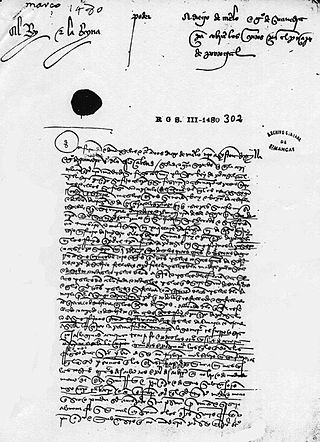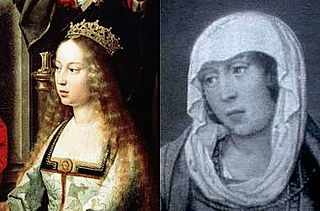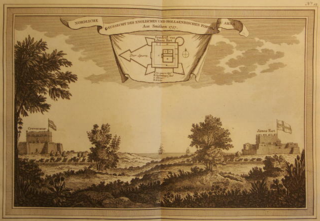
The Portuguese Empire, also known as the Portuguese Overseas or the Portuguese Colonial Empire, was composed of the overseas colonies, factories, and later overseas territories, governed by the Kingdom of Portugal. It was one of the longest-lived colonial empires in European history, lasting almost six centuries from the conquest of Ceuta in North Africa in 1415, to the transfer of sovereignty over Macau to China in 1999. The empire began in the 15th century, and from the early 16th century it stretched across the globe, with bases in Africa, North America, South America, and various regions of Asia and Oceania.

The Treaty of Alcáçovas was signed on 4 September 1479 between the Catholic Monarchs of Castile and Aragon on one side and Afonso V and his son, Prince John of Portugal, on the other side. It put an end to the War of the Castilian Succession, which ended with a victory of the Castilians on land and a Portuguese victory on the sea. The four peace treaties signed at Alcáçovas reflected that outcome: Isabella was recognized as Queen of Castile while Portugal reached hegemony in the Atlantic Ocean.

Cape Coast is a city, fishing port, and the capital of Cape Coast Metropolitan District and Central Region of Ghana. It is one of the country's most historic cities, a World Heritage Site, home to the Cape Coast Castle, with the Gulf of Guinea situated to its south. According to the 2010 census, Cape Coast had a settlement population of 169,894 people. The language of the people of Cape Coast is Fante.

Guinea is a traditional name for the region of the African coast of West Africa which lies along the Gulf of Guinea. It is a naturally moist tropical forest or savanna that stretches along the coast and borders the Sahel belt in the north.

Elmina Castle was erected by the Portuguese in 1482 as Castelo de São Jorge da Mina, also known as Castelo da Mina or simply Mina, in present-day Elmina, Ghana, formerly the Gold Coast. It was the first trading post built on the Gulf of Guinea, and the oldest European building in existence south of the Sahara.

Diogo de Azambuja or Diego de Azambuja (1432–1518) was a Portuguese noble and explorer.

The Dutch Gold Coast or Dutch Guinea, officially Dutch possessions on the Coast of Guinea was a portion of contemporary Ghana that was gradually colonized by the Dutch, beginning in 1612. The Dutch began trading in the area around 1598, joining the Portuguese which had a trading post there since the late 1400s. Eventually, the Dutch Gold Coast became the most important Dutch colony in West Africa after Fort Elmina was captured from the Portuguese in 1637, but fell into disarray after the abolition of the slave trade in the early 19th century. On 6 April 1872, the Dutch Gold Coast was, in accordance with the Anglo-Dutch Treaties of 1870–71, ceded to the United Kingdom.

The Portuguese Gold Coast was a Portuguese colony on the West African Gold Coast along the Gulf of Guinea. Established in 1482, the colony was officially incorporated into Dutch territory in 1642. From their seat of power at the fortress of São Jorge da Mina, the Portuguese commanded a vast internal slave trade, creating a slave network that would expand after the end of Portuguese colonialism in the region. The primary export of the colony was gold, which was obtained through barter with the local population. Portuguese presence along the Gold Coast increased seamanship and trade in the Gulf, introduced American crops into the African agricultural landscape, and made Portuguese an enduring language of trade in the area.

The War of the Castilian Succession was the military conflict contested from 1475 to 1479 for the succession of the Crown of Castile fought between the supporters of Joanna 'la Beltraneja', reputed daughter of the late monarch Henry IV of Castile, and those of Henry's half-sister, Isabella, who was ultimately successful.
Fernão Gomes was a Portuguese merchant and explorer from Lisbon, possibly the son of Tristão Gomes de Brito.

Portuguese maritime exploration resulted in the numerous territories and maritime routes recorded by the Portuguese as a result of their intensive maritime journeys during the 15th and 16th centuries. Portuguese sailors were at the vanguard of European exploration, chronicling and mapping the coasts of Africa and Asia, then known as the East Indies, and Canada and Brazil, in what came to be known as the Age of Discovery.

The Treaty of Axim was concluded between the Netherlands and the chiefs of Axim in the western region of the Gold Coast and signed at Fort St. Anthony near Axim on 17 February 1642. The treaty regulated the jurisdiction of the Netherlands and the Dutch West India Company in the town and polity of Axim after the Dutch West India Company had successfully attacked the Portuguese who were the occupants of Fort St. Anthony in the town. Over time, the agreement was in part superseded and replaced by new contracts and agreements. The treaty did remain the basis for Dutch jurisdiction and political relations between Axim and the Dutch until the latter left the Gold Coast in 1872.

The Battle of Guinea took place on the Gulf of Guinea, in western Africa, 1478, between a Portuguese fleet and a Castilian fleet in the context of the War of the Castilian Succession.

Fort Coenraadsburg or Conraadsburg, also Fort São Tiago da Mina, is a small Portuguese chapel built in honor of Saint Jago and it is situated opposite the Elmina Castle in the Central region of Ghana, to protect Fort Elmina from attacks. Owing to its historical importance and testimony to the Atlantic slave trade, Fort Conraadsburg was inscribed on the UNESCO World Heritage List in 1979 along with several other castles in Ghana.

Ussher Fort is a fort in Accra, Ghana. It was built by the Dutch in 1649 as Fort Crèvecœur, and is two days' march from Elmina and to the east of Accra on a rocky point between two lagoons. It was one of three forts that Europeans built in the region during the middle of the 17th century. Fort Crèvecœur was part of the Dutch Gold Coast. The Anglo-Dutch Gold Coast Treaty (1867), which defined areas of influence on the Gold Coast, transferred it to the British in 1868. Because of its significance in the history of European colonial trade and exploitation in Africa, the fort was inscribed on the UNESCO World Heritage List in 1979.

The Bakatue Festival is celebrated by the chiefs and peoples of Elmina in the Central Region of Ghana. The festival, established at least as far back as 1847, is celebrated on the first Tuesday in the month of July every year.
The Dutch–Ahanta War was a conflict between the Netherlands and the Ahanta between 1837 and 1839. Beginning with a mere economic dispute between the Ahanta and the Dutch, who were based at the Dutch Gold Coast, the conflict ended with the hanging of Ahanta king Badu Bonsu II and the reorganization of the Ahanta state, establishing a Dutch protectorate over the Ahanta.

A slave fort or slave castle was a fortification designed to provide an area in which enslaved victims would be kept until sails were ready to set them aboard and forcefully migrate the enslaved people during the atlantic slave trade. A slave fort was a militarised factory which evolved at locations where the slave trade played a significant economic role on the coast of Africa. These forts were built by organisations from nine European countries, whether by the state or chartered companies.
Ghana was initially referred to as the Gold Coast. After attaining independence, the country's first sovereign government named the state after the Ghana Empire in modern Mauritania and Mali. Gold Coast was initially inhabited by different states, empires and ethnic groups before its colonization by the British Empire. The earliest known physical remains of the earliest man in Ghana were first discovered by archaeologists in a rock shelter at Kintampo during the 1960s. The remains were dated to be 5000 years old and it marked the period of transition to sedentism in Ghana. Early Ghanaians used Acheulean stone tools as hunter gatherers during the Early stone age. These stone tools evolved throughout the Middle and Late Stone Ages, during which some early Ghanaians inhabited caves.

The documented history of Elmina begins in 1482 with an agreement between the Portuguese navigator Diogo de Azambuja and the ruler of Elmina, called Caramansa by the Portuguese. In it, the Portuguese were allowed to build the first European fortress in sub-Saharan Africa. For the next 150 years until the conquest by the Dutch in 1637, Elmina was the capital of the Portuguese bases on the Gold Coast, then for about 250 years the capital of the Dutch Empire in West Africa. Since the capture of the lease for the two fortresses of Elmina by the Ashanti in 1701, the city was also important to the Ashanti Empire. Until the 19th century, Elmina was one of the most populous cities in the Gold Coast, surpassing Accra and Kumasi. The trade in gold, slaves and palm oil brought the city into direct contact with Europe, North America, Brazil and, through the recruitment of soldiers, also with Southeast Asia. It was not until the takeover and destruction of the city by the British in 1873 that Elmina lost its prominent position in the Gold Coast.

























